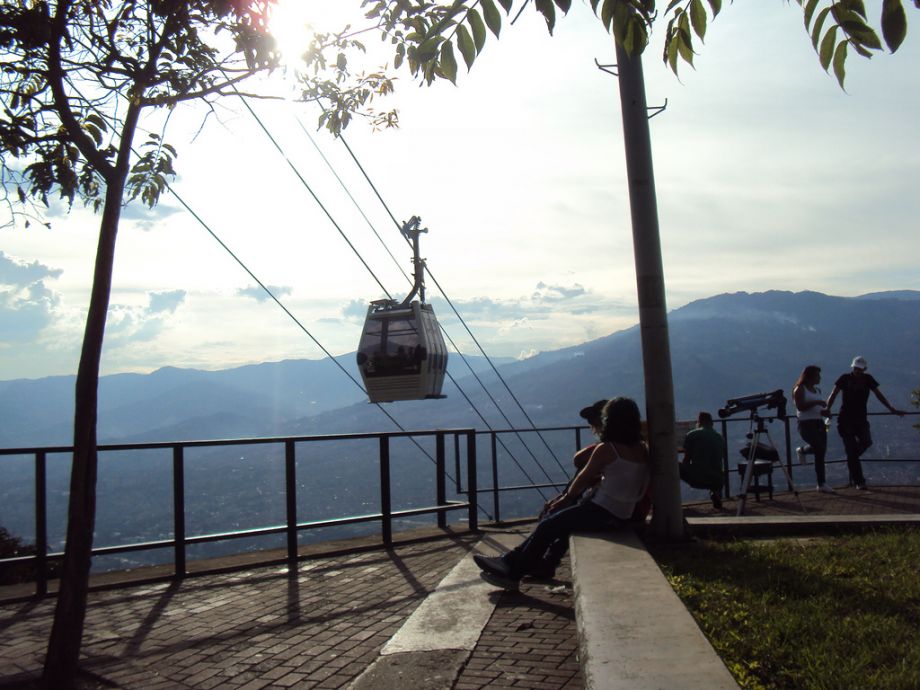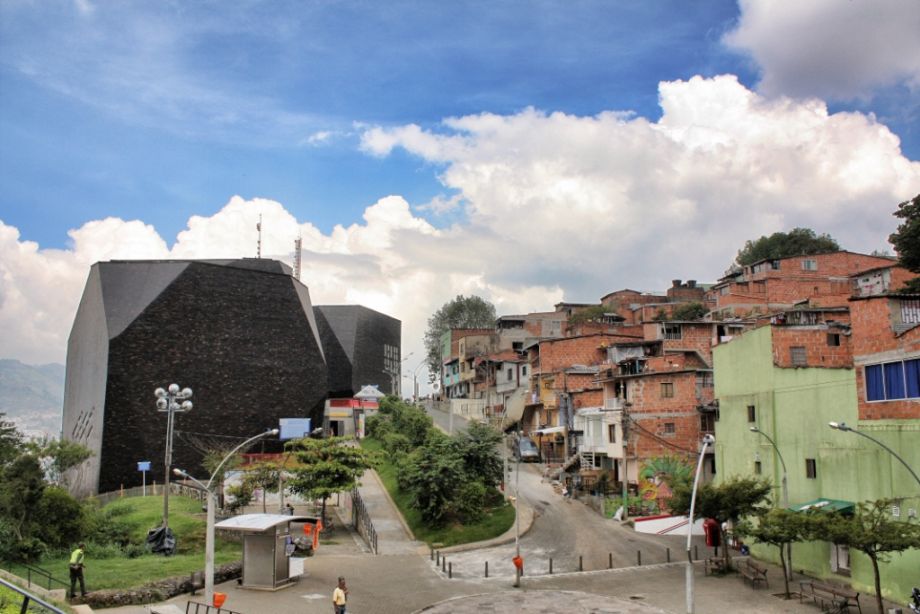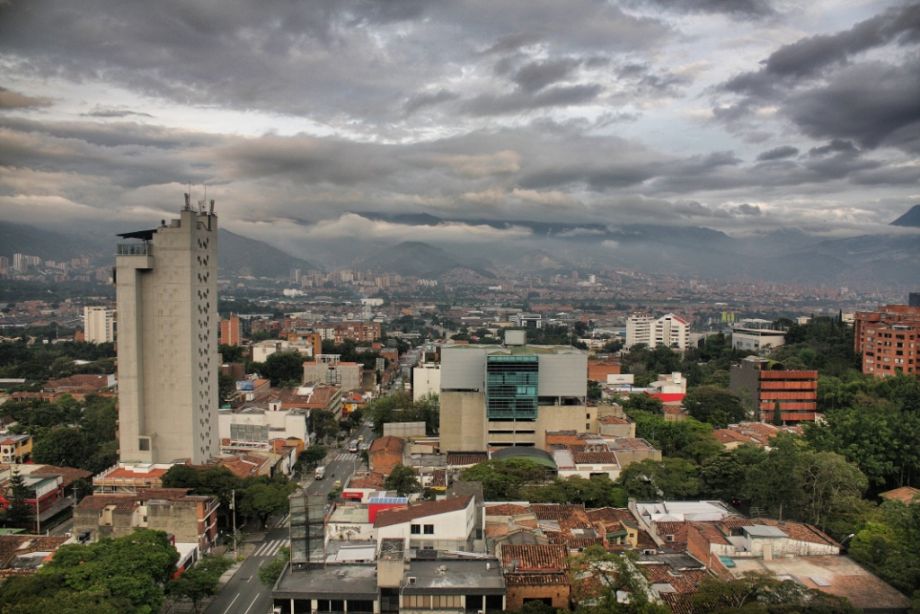Are You A Vanguard? Applications Now Open
Luis Hernesto Holguin, left, and his sister Resfa Holguin use outdoor escalators, newly installed at Comuna 13 shantytown as part of an urbanization plan to improve living conditions of residents, in Medellín. (AP Photo/Luis Benav
The Medellín Cartel, headed by Pablo Escobar, perhaps the only drug lord to become a worldwide household name, transported billions of dollars worth of cocaine, which had surpassed coffee as Colombia’s leading export by 1982. Arriving on U.S. shores, the exploits of cocaine cowboys made Miami the murder capital of the world in the early ’80s, an ignominious title Medellín itself stole in 1991, when it topped out at 381 murders per 100,000 residents, 40 times what the United Nations considers “epidemic.” That rate, if translated to New York City, would equal an unfathomable 32,000 murders annually.
In 1993, Escobar was killed by Colombian special forces, and a decade later, in 2004, the city’s first Metrocable gondola line opened, inaugurating Medellín’s now celebrated urbanismo social (social urbanism) agenda. Now, ten years after that gondola first connected the city’s poorer hillside neighborhoods to its bustling central business district, Medellín finds itself on the global stage once again, this time as a city basking in the glow of admiration for pioneering a new type of urbanism. The city’s newfound fame will be on full view for attendees of next week’s UN-Habitat World Urban Forum (WUF).
The significance of Medellín’s transformation cannot be overstated. Through bold moves in architecture, planning and urban design, it has gone from lost cause to becoming, in 2012, “Innovative City of the Year” as declared by a joint Citi/Urban Land Institute/Wall Street Journal contest. Last year, architect Alejandro Echeverri, director general of the Urban Development Company from 2004 to 2005, accepted the Veronica Rudge Green Prize in Urban Design from the Harvard Graduate School of Design for the Northeast Urban Integration Project, the centerpiece of which was the gondola.
Suddenly, Medellín has become a best-practices case study for mayors and policymakers worldwide. At 2.4 million residents, it is slightly smaller than Chicago, and with a metro area of only 3.5 million, about the size of greater Seattle. Founded in 1616 by Spanish conquistadores, it’s nestled in an Andean river valley at 5,000 feet above sea level, with a pleasant climate that has earned it the nickname City of Eternal Spring. A colonial mining city, it became provincial capital in the early 19th century after Colombia’s independence, and remained a center of gold and coffee exportation.
Most of the 20th century was not kind to Colombia, from the collapse of the coffee market in the 1930s to a brutal civil war in the ’50s and then, of course, the drug wars of the late 20th century. Medellín’s population tripled from 1951 to 1973, when it crested one million inhabitants. Many took refuge on the hillsides in squatter neighborhoods known as comunas, in a geography and social condition similar to Rio de Janeiro’s favelas.
It was around the turn of the century that Medellín’s rebirth began. In an effort to repair yet another divided Latin American city, Mayor Sergio Fajardo, the son of one of Colombia’s most famous architects, made a bold declaration during his 2003-2007 administration. “Our most beautiful buildings must be in our poorest areas,” Fajardo said.
This was – and continues to be – a radical idea in an urban world where most cities locate their Central Parks and Trafalgar Squares in prosperous, tourist-friendly districts. But rather than simply sprouting top-notch architecture in the comunas, the Medellín city government adopted an approach called the integral urban project (PUI in Spanish). Each architectural and urban design intervention was viewed holistically as part of a comprehensive plan for neighborhood revitalization. Thus, the famed Metrocable Line K terminated in the rough Santo Domingo neighborhood at a civic symbol: España Library, an obsidian complex on a dramatic hillside surrounded by a landscaped park. As a dual-purpose commuter and visitor route, Line K has a steady stream of users throughout the day. Careful planning and diagnostics also led to choices for station locations that disrupted the drug trade.

The Metrocable system has connected the city’s outer neighborhoods with its downtown. Photo credit: Guía de Viajes Oficial de Medellín via Flickr
The Metrocable is a great example of how social urbanism creates a double-dividend, simultaneously dissolving the bonds of narco-trafficking while also improving daily quality of life. As Echeverri explained in a 2011 interview, “With the location of stations, libraries and schools, we are creating a system of local urbanity. In theory, this is going to touch a lot of people’s lives.”
Metrocable was such a success that it has expanded to two other lines, including an extension of Line K that provides affordable access to a mountaintop nature preserve. Administered by the Metro de Medellín, an efficiently run transit agency, the gondolas are not a money loser and were initially financed by a public-private partnership, as were other projects pursued by the Urban Development Company, such as headline-grabbing escalators installed as part of an urban makeover of a neighborhood called Comuna 13.
This model has been lauded – and critiqued. While the Medellín miracle has given rise to a more robust city, it’s done so by relying on a neoliberal constellation of corporate partners and powerful multinationals. The Grupo Empresarial Antioqueño (Business Group of Antioquia) is a coalition of businesses representing 125 companies in the Antioquia department, the vast majority of which are located in the capital of Medellín. Led by a quartet of the city’s corporate titans – the country’s largest commercial bank Bancolombia, cement manufacturer Argos, insurance giant Sura and food manufacturer Nutresa — the coalition generates seven percent of the Colombian GDP and an aggregate market capitalization of around $17 billion USD. Complementing the locals, several foreign companies have recently set up their Colombian shops in Medellín, from Toyota and Mitsubishi to Phillip Morris and Kimberly Clark.
It isn’t only in the last decade that the private sector has emerged as a powerful force in Medellín. Carolina Barco, an urban planner and former Colombian ambassador to the U.S., points out the strong historic connection of the business community to the city: “The private sector in Medellin has always played a very important role because of the commitment of the business leadership with good governance as exemplified by Proantioquia.” Founded in 1975, Proantuoquia is a non-profit foundation headed by local entrepreneurs that weathered the storm of the cartel years rather than fleeing abroad, and subsequently encouraged the private sector to participate in the revitalizing public policies that emerged over the last two decades. She notes, “The private sector donated their work in the design of the [social urbanism] projects and invested in many of them.”

Top-notch amenities like parks and libraries have been placed in some of the city’s poorest neighborhoods. Photo credit: Jorge Gobbi via Flickr
As is often the case when the business community wants to invest in city infrastructure, the end result is public-private partnership. Barco notes, “The private sector has always been very supportive of Empresas Publicas de Medellín (EPM), the very efficient public services company of Medellin which also generates resources for social programs.” Indeed, the revenue generated by EPM largely financed the city’s mid-2000s spending spree on infrastructure and social programs. PUIs don’t come cheap – Comuna 13’s makeover cost a cool $155 million over three years. No wonder that municipal spending doubled from 2004 to 2008.
At the same time, Medellín is one of the largest cities in the world to practice participatory budgeting, allocating five percent of the city budget to the cause. Municipal legislation provides for communal councils and neighborhood assemblies that receive funds based on a progressive formula, weighted in favor of communities with a lower quality of life and higher participation rates in the councils. The process has given a boost to Son Batá, an Afro-Colombian music ensemble that has morphed from a band to a social service provider thanks to the participatory budgeting funds, which have been used to hire music teachers and pay for instruments. Other neighborhoods have landed schools and health clinics through the funding scheme, which Barco believes “increases the citizens’ commitment to their barrio and to the city as a whole.”
While the architects of Medellín’s turnaround emphasize their commitment to community participation in the PUIs, there is still some discord over the process. Rubyselen Ortiz Sánchez, a journalist that lives in Comuna 8, believes that the city’s reputation is a “myth.”
“The celebration of Medellín for its innovation was not a complete prize,” Sanchez said. She points to the eight criteria for the most innovative city prize, and says there’s a local deficit in five of them: culture and livability, progress and potential, places of power, education and human capital, and research and technology. “This is evidence that the city has important challenges to meet for its residents in terms of equity, job creation and the fight against poverty and inequality,” Sánchez argues.
But even as the city’s approach is debated, the results are undeniable. It’s a strategy in transition – far from complete, with great potential but still clearly getting its legs under it. For instance, by 2007 the Medellín homicide rate plummeted to a tenth of its 1991 peak, but it doubled four years later as the local drug trade has not entirely been extinguished. The U.S.-backed Plan Colombia helped the national government reduce the FARC, a left-wing guerrilla group, to a fraction of its former terrorizing self, but only after right-wing paramilitaries formed an umbrella group and the two duked it out in a bloody conflict second only to the 1950s civil war. Meanwhile, typical of starchitecture, España Library has serious problems with its interior. It’s enough for Francis Fukuyama to declare Medellín “half a miracle.”

Though the city’s transformation has been dramatic, Medellín still suffers from many of the problems of its past. Photo credit: Jorge Gobbi via Flickr
Nevertheless, successive administrations have kept Fajardo’s vision aloft, pursuing a variety of projects, including a design competition to revitalize the channelized Medellín River, rezoning to densify the central city and a greenbelt to contain both formal and informal hillside growth that could despoil the city’s verdant edges. While the well-respected EPM is in charge of cleaning up the river, Sánchez raises a red flag over the greenbelt, which will affect her neighborhood of Comuna 8. Present since the first community meeting on the topic, she believes there has been “false information in place of dialogue” that has undermined confidence in the municipal Urban Development Company.
The combined efforts put Medellín in the class of progressive cities like Portland, Vancouver and its South American neighbor, Curitiba, which became famous starting in the 1970s for its bus rapid transit (BRT), its recycling initiatives and its parks and public spaces. Clara Irázabal, associate professor of planning at Columbia University, is the author of City Making and Urban Governance in the Americas: Curitiba and Portland, and she taught a planning studio on Medellín’s greenbelt in 2013. “Medellín is at that pivotal point now that Curitiba reached,” Irázabal argues, “because it’s at a pinnacle – as certified by the World Urban Forum – and new projects will generate less attention. If Medellín becomes addicted to that recognition they might become disappointed.”
Since its initial ascendance, Curitiba, once hailed as a near-perfect city, has rested on its laurels to a large extent. It only belatedly built a subway line after relying for decades on BRT, fell far behind on a World Cup stadium and now suffers from traffic jams thanks to the highest car-ownership rate in Brazil. But Irázabal believes Medellín may fare better. “I think they are more open to [criticism] in Medellín and hopefully that will prevent some of Curitiba’s letdowns from being reproduced there. It’s a great risk to be a victim of one’s own success.”
Natalie Quinn, a second-year planning student at Columbia University who participated in Irázabal’s Medellín studio, recalls a child in one of the comunas telling her proudly, “We are the most innovative city in the world because of our libraries and parks.” Her takeaway: “I’ve never been in a city where the common person as so engaged with city planning.”
As hopeful as that impression is for planners eager to learn firsthand from the Colombian metropolis’ turnaround, the specter of Medellín’s “half-miracle” remains. Octavio de Jesús Valencia García, a trucker who since 1947 has lived in Comuna 8, the low-income neighborhood facing the nebulous specter of the greenbelt, has seen over a half-century of the city’s highs and lows. At its nadir in the early ’90s, he recalls, “One day my daughter Kelly was playing in the street. Somebody fired at one of the groups of boys on the corner, and she ended up with a bullet in her left leg. They shot her when she was only nine years old.”
This story is one of thousands from the worst outbreak of drug-related violence in the city, an era that García is thankfully glad to be rid of. However, he is not so quick to credit innovative urbanism with the turn-around. “Compared with today,” he says, “things got a lot better after ‘the pact’ — the rifle pact is a rumor in the city in which the most powerful mafia leaders made an agreement not to confront each other.” The pacto del fusil, more truce than treaty, is disputed by authorities but regarded by many as the primary reason the 2008 spike in homicides has fallen so much — in 2013, reaching its lowest rate in 30 years. For someone like García, that translates into a real improvement in quality of life: “Things calmed down, the neighborhood is relaxed, there are problems like in any neighborhood, delinquents, gossipy neighbors, but we haven’t returned to hearing shootouts, people walk around more relaxed and there’s more activity at night, more parties and everything is calmer.” When the world descends on Medellín next week, they’ll arrive in a city as complex as it is up-and-coming, and one where the forces driving its progress are still not entirely clear.
Rubyselen Ortiz Sánchez contributed to this article from Medellín
Our features are made possible with generous support from The Ford Foundation.

Gregory Scruggs is a Seattle-based independent journalist who writes about solutions for cities. He has covered major international forums on urbanization, climate change, and sustainable development where he has interviewed dozens of mayors and high-ranking officials in order to tell powerful stories about humanity’s urban future. He has reported at street level from more than two dozen countries on solutions to hot-button issues facing cities, from housing to transportation to civic engagement to social equity. In 2017, he won a United Nations Correspondents Association award for his coverage of global urbanization and the UN’s Habitat III summit on the future of cities. He is a member of the American Institute of Certified Planners.

20th Anniversary Solutions of the Year magazine